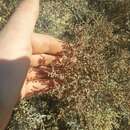en
names in breadcrumbs


Heterostachys ist eine Pflanzengattung in der Familie der Fuchsschwanzgewächse (Amaranthaceae). Es sind strauchige Salzpflanzen mit ungegliederten Sprossachsen und stark reduzierten Blättern und Blüten. Sie kommen in Zentral- und Südamerika vor.
Die Heterostachys-Arten sind Halbsträucher oder kleine Sträucher. Die verzweigten Stängel sind kahl und nicht gegliedert. Die Laubblätter stehen wechselständig, sie sind fleischig, kahl, schuppenförmig, den Stängel umfassend, ihre freie Blattspreite ist nur ein bis zwei Millimeter lang.[1]
Die kugel- bis zapfenförmigen Blütenstände bestehen aus wechselständigen bis fast gegenständigen schuppenförmigen Tragblättern, in deren Achsel jeweils eine einzelne, freie Blüte sitzt. Die zwittrigen Blüten besitzen vier halb miteinander verwachsene, ungleich große Tepalen, zwei Staubblätter und einen Fruchtknoten mit zwei Narben.[1]
Zur Fruchtzeit wird die Blütenhülle dick und schwammartig. Die Fruchtwand ist häutig. Der Same ist linsenförmig bis keilförmig und besitzt eine höckerige Oberfläche. Der Embryo ist halb-ringförmig, es ist reichlich Nährgewebe vorhanden.[1]
Die Arten von Heterostachys sind in Zentral- und Südamerika verbreitet.[1] Als Salzpflanzen besiedeln sie Küstenlagunen und salzige Stellen im Inland.
Die Gattung Heterostachys wurde 1876 von Franz Ungern-Sternberg aufgestellt.[2] Damit ersetzte er den von ihm 1866 beschriebenen, aber ungültigen Namen Spirostachys Ung.-Sternb.[3] (dieser ist illegitim, weil bereits Spirostachys Sond. existierte). Die Typusart ist Heterostachys ritteriana.[4]
Die Gattung umfasst zwei Arten:[1]
Heterostachys ist nah verwandt mit Allenrolfea, die ebenfalls in Amerika verbreitet ist. Ihre gemeinsame Abstammungslinie hat sich schon früh entwickelt (im Frühen bis Mittleren Oligozän), im gleichen Zeitraum wie die frühen eurasischen Abstammungslinien der Salicornieae. Vermutlich haben sie Amerika lange vor allen anderen amerikanischen Vertretern der Salicornieae erreicht.[1]
Heterostachys ist eine Pflanzengattung in der Familie der Fuchsschwanzgewächse (Amaranthaceae). Es sind strauchige Salzpflanzen mit ungegliederten Sprossachsen und stark reduzierten Blättern und Blüten. Sie kommen in Zentral- und Südamerika vor.
Heterostachys is a genus of flowering plants in the plant family Amaranthaceae. The two species are shrubby halophytes native to South America and Central America.
The species of Heterostachys grow as subshrubs or low shrubs. The stems are much branched, glabrous, and not jointed. The alternate leaves are fleshy, glabrous, scale-like, stem-clasping, with very short free blades (1–2 mm).[1]
The inflorescences are orbicular to cone-like, with alternate to nearly opposite scale-like bracts, and with one free flower sitting in the axil of each bract. The flowers are bisexual. The four-lobed perianth consists of four half-connate unequal tepals. There are two stamens and an ovary with two stigmas.[1]
In fruit the perianth becomes thick and spongy. The fruit wall (pericarp) is membranous. The seed is lenticular to edge-shaped with tuberculate surface. It contains a semi-annular embryo and copious perisperm (feeding tissue).[1]
Heterostachys is distributed in South America and Central America (Hispaniola).[1][2] The plants are halophytes and grow in coastal lagoons and salty inland habitats.[1]
The genus Heterostachys was first published in 1876 by Franz Ungern-Sternberg.[3] With this description, he replaced the invalid name Spirostachys Ung.-Sternb. from 1866,[4] (which is illegitimate, as Spirostachys Sond. already existed since 1850). The type species is Heterostachys ritteriana.[5]
The genus comprises two species:[1]
Heterostachys is closely related to the genus Allenrolfea, which also is distributed in America. Their common lineage seems to have evolved early in the evolution of the subfamily Salicornioideae, dating back to the Early to Middle Oligocene. It might have reached America long before the other American taxa of Salicornioideae.[1]
Heterostachys is a genus of flowering plants in the plant family Amaranthaceae. The two species are shrubby halophytes native to South America and Central America.
Heterostachys es un género de plantas fanerógamas con dos especies[1] pertenecientes a la familia Amaranthaceae.[2]
El género fue descrito por Franz Ungern-Sternberg y publicado en Atti del congresso internazionale botanico tenuto in Firenze nel mese di maggio 1874 267, 268, 331. 1874[1876][3] La especie tipo es: Heterostachys ritteriana (Moq.) Ung.-Sternb.
A continuación se brinda un listado de las especies del género Heterostachys aceptadas hasta octubre de 2012, ordenadas alfabéticamente. Para cada una se indica el nombre binomial seguido del autor, abreviado según las convenciones y usos.
Heterostachys es un género de plantas fanerógamas con dos especies pertenecientes a la familia Amaranthaceae.
Heterostachys é um género botânico pertencente à família Amaranthaceae[1].
Heterostachys é um género botânico pertencente à família Amaranthaceae.
«Heterostachys — World Flora Online». www.worldfloraonline.org. Consultado em 19 de agosto de 2020Heterostachys là chi thực vật có hoa trong họ Amaranthaceae.[1]
Heterostachys là chi thực vật có hoa trong họ Amaranthaceae.